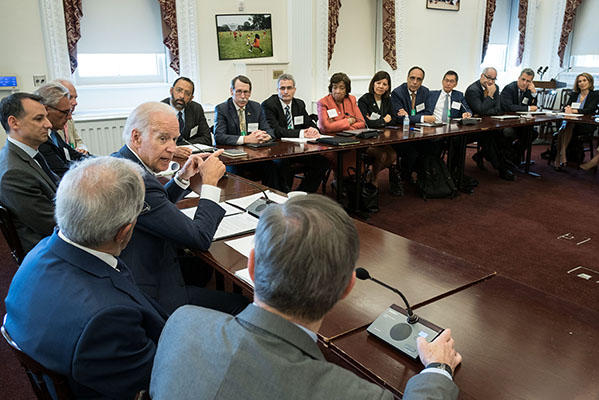The Moonshot Blue Ribbon Panel: Moving Toward a Final Report
, by Douglas R. Lowy, M.D.
I hope that, by now, most in the cancer community have seen Vice President Biden’s address at the 2016 annual meeting of the American Society of Clinical Oncology. It was an inspiring presentation, with the Vice President highlighting the launch of the Genomic Data Commons and emphasizing the essential role the research community will play in achieving the National Cancer Moonshot Initiative’s goals.
I’d like to give you an update on other things that have happened with this important initiative since my last post in Cancer Currents, but let me just preface this by saying that it’s been anything but business as usual for NCI.
The Moonshot’s Blue Ribbon Panel is responsible for recommending and guiding the scientific direction and cancer research efforts to be funded by the initiative over the coming years. To facilitate its work, the panel created seven working groups, each comprising more than a dozen researchers, patient advocates, and private sector representatives with expertise in the seven priority areas that have emerged during this process. The working groups, which began meeting weekly in May, are charged with identifying and recommending promising research opportunities within their respective areas that could be accelerated with additional funding.
NCI also invited researchers and the general public to submit their best ideas for accelerating cancer research to the working groups for consideration. To date, more than 400 ideas have been submitted via NCI’s CancerResearchIdeas.cancer.gov engagement platform. I encourage you to submit your ideas if you haven’t yet done so. The deadline for submissions is July 1 to give the working groups time to consider the submitted ideas before finalizing their recommendations this summer. Although not all of the submitted ideas will make it into the Blue Ribbon Panel's final report, all of the ideas will be given serious consideration.
Let me clarify that not everything that is important in cancer will be covered by the Moonshot. This initiative encompasses only one part of NCI’s overall budget and planning efforts. Rest assured that all ideas—be they submissions from the working groups or the public—will not disappear into a black hole. I will be sharing submissions for meritorious projects with NCI’s advisory boards for future research planning beyond the Moonshot.
The effort and commitment of the Blue Ribbon Panel and its working groups have been truly astounding. Leaders from across the cancer community placed their already full schedules on hold to roll up their sleeves and focus on this important work. The culmination of this effort will be a report to the National Cancer Advisory Board in August, which will include 5–10 of the most promising opportunities that, with additional funding and focus under the Moonshot, are poised to produce significant progress within a short period of time.
This past week, the Blue Ribbon Panel gathered in person to discuss approximately 20 preliminary recommendations and cross-cutting themes that have emerged from the working groups’ deliberations. During the meeting, the panel also met with Vice President Biden at the White House to share their thinking to date. Another Blue Ribbon Panel meeting will take place before mid-August to discuss and finalize a whittled down list of recommended ideas.
The Vice President’s enthusiasm for the ideas that have been generated, and his respect for the collective expertise in the room, was both palpable and moving. The recommendations put forth that day are all concrete, patient-centric, and, importantly, actionable. Many are proposals that could get off the ground immediately. If implemented, these recommendations could change the trajectory of cancer prevention and treatment.
Here are a few examples:
- Develop new ways to make it easier for patients to find and participate in clinical trials. Tying in well with this recommendation is a proposal to create a national registry of patients with cancer who are interested in volunteering for clinical trials, which trial recruiters could access. Currently, only about 5% of adult cancer patients in the United States participate in clinical trials. Recommendations such as these, it is hoped, would lead to increased rates of participation and quicker progress.
- Develop a virtual formulary, or library, of cancer drugs that NCI would manage. The availability of a large number of investigational and approved drugs would make it easier for researchers to test combinations of therapies and speed the development and delivery of new and effective treatments for cancer patients.
- Establish collaborative teams to acquire and characterize pediatric tumor tissues on a much larger scale than is currently done through existing programs. Conducting genomic studies on these samples would increase our understanding of the molecular and biochemical mechanisms responsible for treatment resistance and disease recurrence in children with cancer and potentially identify new therapies for children and adults.
- Target uptake of proven cancer prevention strategies for three highly preventable forms of cancer—cervical, colorectal, and lung—among populations with the greatest need by developing scalable and tailored community-based interventions. Higher rates of HPV vaccination and colorectal cancer screening and more broadly implemented tobacco control programs would greatly reduce the incidence of these preventable cancers.
- Implement genetic testing on a wider scale in family members of people with Lynch syndrome and other inherited cancer-associated genetic mutations to determine whether they have inherited the same mutations. Inherited mutations in certain genes increase the risk of developing Lynch syndrome, which is associated with colorectal, uterine, and other types of cancer. Nearly three-quarters of a million people in the United States have Lynch syndrome, yet only 5% know they have it. Broader testing would provide important information to people with these mutations and help to guide their future medical care. In addition, following this group will allow us to learn about the disease process and why some go on to develop cancer and others do not.
These are just a few of the many inspiring ideas that were discussed at last week’s meeting. Armed with feedback from the Blue Ribbon Panel and the Vice President, the working groups are back at work refining their recommendations in preparation for final consideration by the full panel in just a few weeks.
I can’t emphasize enough what an exciting time this is in cancer research. I am truly inspired by the collective will of the community to come forward with their best ideas for making progress. Together we will go far in changing the trajectory of cancer.

